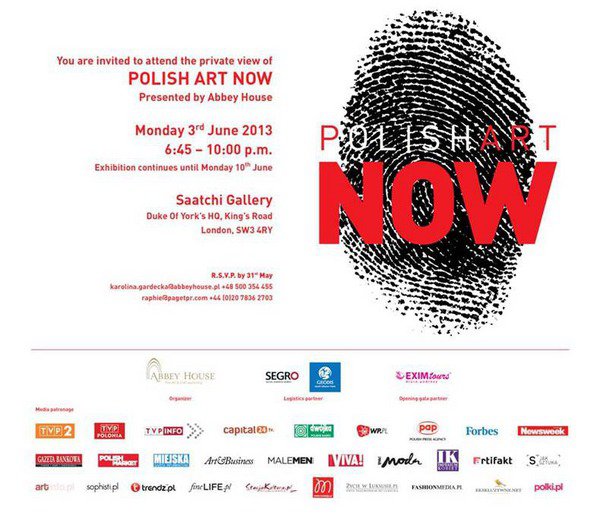Polish Art Now
dal 2/6/2013 al 9/6/2013
Segnalato da
2/6/2013
Polish Art Now
New Saatchi Gallery, London
This survey aims to increase international awareness of the burgeoning Polish art scene. The exhibition will showcase work by some of the country's foremost contemporary artists.

Any selection of work by contemporary artists inevitably involves a visit to the past. A history of a specific country’s art shows that there is a reflection, a parallel, with the history of the country itself. Major differences denote contemporary Polish art, obviously, and while Polish artists work effectively around the world, the object of this exhibition is to show a small range of work by people who work inside the country, inevitably affected by particular structure and tradition.
Andrzej Cisowski who studied in Germany uses a relation to photography and collage, where image effect and element are placed into constructed space, to utilise a method more commonly associated with the 1980s. The large paintings bring with cartoon, outline, and illusion elements that make much and little sense in terms of each other: a cat stares out, a figure is prone on virtually painted bedding, in an illusory, somewhat collapsed space where fantasy and fact collide.
While Cisowski uses pictures within pictures, a gamut of historical devices to question collective memory and moment, Szymon Urbański’s deliberately heavy-handed touch suggests a heightened frustration with the present. His play on and in the art of expression and aggression brings anger, attitude and high colour in dead locked graphic impasto.
Stanisław Młodożeniec’s work shows a shift from compliments to Klee and Miró, a build up if drawn line in pain constructing place and point across the canvas, to a series of lightly touched works on paper with an almost diaristic range of reference, quote, place and incident interrupted every now and then by abstract painting that works its way across the paper with expectation, desire, and a strong nod to metaphysical painting.
Ranging over time from political art, performance, sculpture and painting to print, the work of Marek Niemirski, which currently consists of an ongoing, necessarily incomplete project, comes out of an immersion in the art and history of Poland. Each in the series of large format paintings of finger and thumb prints taken by Niemirski from Polish artists, are dated two, sometimes three times to represent the day the print was taken, the day the painting was completed, and even, in a few cases, the day the subject died. These labour intensive renderings in black and white turn detailed mark into experiential generality, as the balance between the real print as point and iconic centralised image comes dusted, powdered, and pursued with the same level of attention as that of a detective. Niemirski also likens the images to musical notation, with the white of paint almost like the groove in the record.
A focal point of the exhibition is the display not only of work by Niemirski but the inclusion of crucial works from his own collection, by artists whose fingerprints he has collected. A really great example of Wojciech Fangor’s spatially open painting, for instance, provides a chance for luxuriant experience and functions like a key at the side of the map. Each of the four historical pieces by Stefan Gierowski, Aleksander Kobzdej, Eugeniusz Markowski and Henryk Stażewski can be seen to provide a context for the more recent work.
Without literally lining up any similarities, it is interesting to see that slight difference, a shift, though obviously often on a conceptually different basis, through generations, gives a chance to see this work, mainly shown for the first time in London, in a way that is helpful. There are great strands of abstraction, from Stażewski, through Gierowski and Fangor to Anna Szprynger’s labour. The latter one’s intensive, detailed monochrome paintings make or mimic fine renditions of movement, almost, in some cases, as if water has drained off, light is glimpsed, and illusion is built up through a process of production. Jan Wyżykowski uses a sort of pointillism of small mark to build circles or diffuse fields of radiating colour. His series of ten paintings of four circles of colour, based on Goethe’s colour theory, merge pop with notation, the image itself lending to ideas of reverberating sound and pulsating speakers.
Eugeniusz Markowski’s devilish, distorted expression, on the other hand, provides a key to another strand in the exhibition. Agata Kleczkowska paints a range of high pitched imagery, a stag at bay outlined against a radiating geometry, for instance, palmistry hands splayed against a mountainside. Her textile, a rendition of childhood drawing sewn with thread onto a rough piece of cotton, carries a slower relation to meaning and time.
The apparent closeness of matters between generations is exciting and useful yet perhaps simplistic. This is a new generation in more than formal terms. Jakub Słomkowski makes invented generic, at times a touch surrealist, landscape paintings. He allows the limitation of the invention of space to provide its own place but he is an active collaborative performance artist with a practise bound up in working with musicians and dancers at the same time. The solitary sculpture here, by Julia Bistuła, alludes to the process of extension and growth to create an essential, patently temporary, but nonetheless real presence.
Sacha Craddock
New Saatchi Gallery
Duke of York's HQ King's Road SW3 4SQ, London
Hours: 10am-6pm, 7 days a week, last entry 5:30pm
Free Admission



